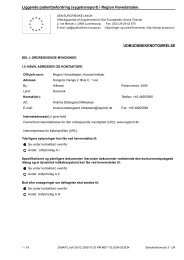Territorial Review Copenhagen - Region Hovedstaden
Territorial Review Copenhagen - Region Hovedstaden
Territorial Review Copenhagen - Region Hovedstaden
Create successful ePaper yourself
Turn your PDF publications into a flip-book with our unique Google optimized e-Paper software.
245<br />
efficiency of the labour market, by opening up a larger, higher-quality<br />
labour pool and a wider range of services to key employers and producers.<br />
The cost of achieving a true single economic space may however be<br />
extremely high, due to the infrastructure investment required. Collaboration<br />
is more likely to become a valuable economic strategy in regions where<br />
there are fewer, larger dominant urban centres rather than those<br />
characterised by a complex network of cities (Docherty et al., 2004).<br />
Measurement of urban competitiveness<br />
Competitiveness of firms represents the capacity of a business or the<br />
businesses of an area to sell its products in contested markets. The emphasis<br />
on contested markets is clearly important in order to avoid attributing<br />
competitiveness to cases which are protected from any strong competition.<br />
There are three kind of indicators that measure this: export, growth and<br />
productivity performance. Export markets may be expected to be the most<br />
widely contested. Firms from all areas might be expected to face a<br />
comparable set of competitors there, which may well not be true in different<br />
national and regional markets. Section 1.2 of this <strong>Review</strong> focuses on the<br />
competitiveness of firms in <strong>Copenhagen</strong>.<br />
Some authors take the aggregate of firms‘ competitiveness in a region as<br />
a proxy for regional competitiveness. Some models for urban<br />
competitiveness have for example taken the growth in manufacturing value<br />
added, retail sales and business services receipts into account (Kresl and<br />
Singh, 1999). Although competitive firms often translate into regional<br />
welfare, this is not necessarily the case. Separate measurement of urban<br />
competitiveness is therefore necessary.<br />
The consumer price index in large cities is slightly higher than the<br />
national average, but the land rent in large cities is much higher than the<br />
national average. Due to these variations in price differentials, it is not<br />
certain whether the real income in larger cities is higher or lower.<br />
Glaeser et al. (1995) argued that in the analysis of regional growth, the<br />
appropriate dependent variable was population growth. They argued that<br />
equilibrium implied that the real returns to labour would be equalised<br />
between regions on the margin (since labour would vote with its feet if<br />
higher real returns were available elsewhere) and price differences and<br />
differences in the quality of life (climate, natural amenities or local<br />
pollution, for example) would be fully reflected in money incomes. In their<br />
view, the most appropriate measure of differences in regional growth in<br />
prosperity would be employment and population growth.

















